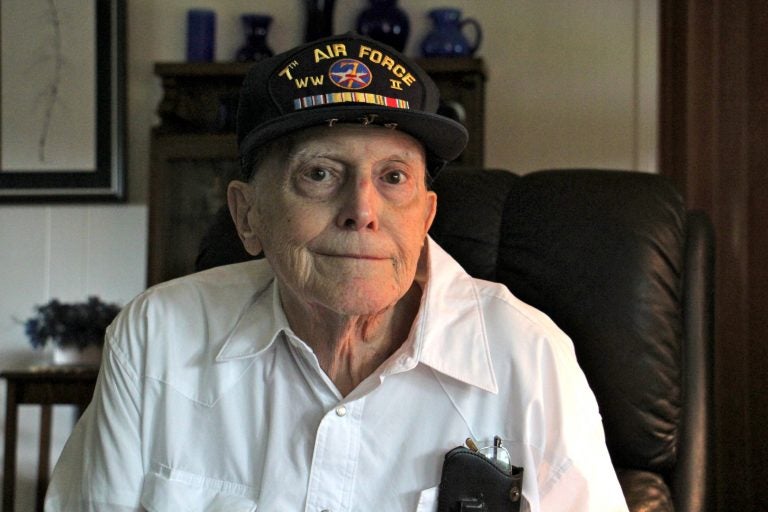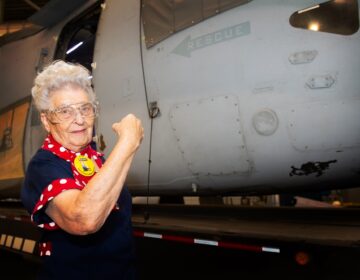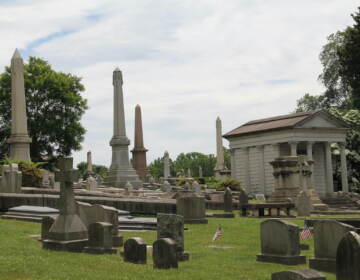When the Atomic Age began 73 years ago, this Pennsylvania man was there
Charlie Reddig happened to fly his plane over Hiroshima the same day U.S. forces hit it with an atomic bomb. 'What happened to all these people,' he wondered.
Listen 4:29
World War II veteran Charles Reddig, flying a mission over Japan, saw the atomic bomb explode over Hiroshima and the devastation it left behind. (Emma Lee/WHYY)
One of the first things you notice about Maj. Charles Reddig is his laugh — deep, hearty, and surprisingly frequent when he talks about his time as a bomber pilot in World War II.
He laughs when he describes his interactions with native people in the Gilbert Islands in the Pacific, or the time he took a random GI for a plane ride in Hawaii and found out, midair, that his passenger was Yankee slugger Joe DiMaggio.
“I went, uh oh, I wonder if this is the ballplayer,” Reddig said, before uncorking another laugh, each guffaw a little softer and a little longer until his breath fades away.
When Reddig starts talking about Aug. 6, 1945, it sounds like another one of his fantastical wartime adventures. It would be the last of his 69 combat missions, and it started with a bombing run on Tokyo. Feeling impish, the crew snapped pictures of Emperor Hirohito’s castle on their way back to base.

‘No idea what it was’
En route, Reddig and his crew spotted a mushroom-shaped cloud over Hiroshima.
“I can still almost see it clearly,” Reddig said.
Here, the war story stops and something more dreadful emerges.
“My top turret gunner, who can see everything, he gets me on the air, and he says, ‘Are we lost?’ I said, ‘No, what do you mean are we lost?’ And he said, ‘Look down.’ ”
When Reddig tilted the nose of his plane toward the ground below, he couldn’t believe his eyes.
“There was nothing. Nothing. No movement,” he recalled.
Reddig groped for explanations. An earthquake couldn’t have caused devastation so complete. Nor could a flood, which seemed impossible given the weather.
“What happened to all these people? And buses and trucks and cars and everything? They’re gone! And why is only a couple of walls standing where this was a major city,” Reddig asked himself, surveying the scene.
“We had no idea what it was.”
U.S. President Harry Truman soon told the world exactly what it was: an atomic bomb. Reddig saw the aftermath of the first nuclear bomb dropped in combat — one of only two ever used.
Reddig was born in 1924, in the rural hamlet of Fivepointville, Pennsylvania, between Lancaster and Reading. A local doctor tried to ride his sleigh through a snowstorm to deliver baby Charlie, but couldn’t make it in time.
Now, 21 years later, he’d seen the most devastating technology ever unleashed in battle.
“I mean, I just couldn’t imagine,” Reddig said. “I thought maybe I was lost, to be honest about it.”
Reddig would lose his hair temporarily due to radiation exposure.
Then, within days, the war ended, and the decorated pilot returned home to Lancaster County.
He became an electrical engineer and spent decades making televisions at an RCA plant. He still lives on a quiet country road with his wife, Carmen, in a house adorned with fishing trophies and collectible toy planes.
Indelible experience yields combative advice
Reddig didn’t talk much about the war at first, only with fellow veterans. Eventually, he started regaling his three kids with old stories. More recently, he sat down with his daughter, Connie Kirby, for a series of interviews and published the transcripts in a book called “Remembering the Cloud: The True Story of WWII Pilot Charlie Reddig.”
Reclined in his living room lounge chair, Reddig can recall devastation few alive have witnessed. Calls to the Department of Defense, Air Force, and National Archives yielded no definitive answer on whether Reddig is the last living U.S. service member to have seen the destruction in Hiroshima that day. But it’s safe to say he’s one of the last, if not the only one.
One wonders, naturally, what this precious link to the nation’s past thinks about the bomb and its use that day. Turns out, he’s as torn as many Americans.
He thinks it probably saved lives on both sides by hastening the end of the conflict, but still trips over his words while rationalizing. Finally, he lands somewhere in that squishy middle, where diplomatic theory meets the sobriety of his own memory.
“I don’t know if it was right or wrong,” Reddig said. “But I think it was a good idea, y’know.”
Reddig is firmer when it comes to the topic of war. He hates it. America shouldn’t send soldiers to die in foreign countries, he said, unless attacked first by an enemy.
“I shouldn’t really say it, but I don’t think we have any business in some of these other countries,” said Reddig, who continued on with the military part-time after the war as an instructor. “We’re sending our soldiers over there to die for somebody who’s a billionaire with oil. That, to me, doesn’t make sense.”
Reddig has an alternative. When two nations are at odds, he said, their leaders should step into a boxing ring and go 12 rounds.
“Let the best man win,” he said.
When people hear Reddig’s idea, they think the old man is kidding.
He’s not.
“I still think the leaders ought to fight it out,” he said.
Suddenly, from the darkest of places, Charlie Reddig’s laugh resurfaces — still booming seven decades after the biggest blast in human history.
It rumbles, drags, and fades, but has not yet gone quiet.
WHYY is your source for fact-based, in-depth journalism and information. As a nonprofit organization, we rely on financial support from readers like you. Please give today.





